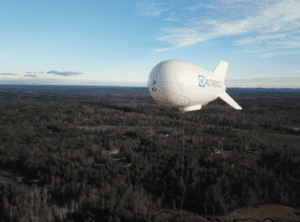Massachusetts-based communications infrastructure provider, Altaeros, launched what it says is the world’s first commercially available aerial cell tower, the SuperTower ST200. Altaeros successfully completed initial testing of the ST200 at its R&D Center in southern New Hampshire. Altaeros is backed by Softbank, Mitsubishi Heavy Industries, the Suhail Bahwan Group, Ratan N. Tata and others.
The SuperTower uses an aerostat platform, combined with automation and control software, to keep the aerial cell tower in place in changing weather and environmental conditions and ensure a stable platform for the telecommunication equipment. Multiple tethers connect the aerostat to the ground and transmit power and data to the airborne equipment. The tower can deploy radios and antennas 800 feet above ground level – higher than traditional cell towers, the company claims. This, according to Altaeros, allows carriers to efficiently cover substantially more area than traditional towers.
The ST200 was tested with six high capacity Ericsson 4G LTE radios and three high-gain Matsing lens antennas. During initial testing users were able to stream high-definition video at distances well beyond the reach of a typical cell site, even in the hills and forests of New England. Altaeros is initially deploying SuperTowers in partnership with carriers in the U.S., with plans to expand internationally.
Historically, service providers have struggled to offer coverage in rural areas due to the high cost of building large networks of remote towers in areas with few subscribers. In its 2018 Broadband Deployment Report, the FCC reported that over 24 million Americans still lack broadband internet, and huge rural portions of the country remain unserved or underserved.
By reducing the number of sites needed in rural markets by 90 percent, the SuperTower offers a quick and inexpensive path to expand service, says Altaeros. It can also accelerate the rollout of new technologies such as 5G and IoT in rural markets. “There is an immense need for a better way to bring connectivity to those who have been left behind by the current generation of infrastructure,” said Altaeros CEO Ben Glass.
February 13, 2019





Reader Interactions